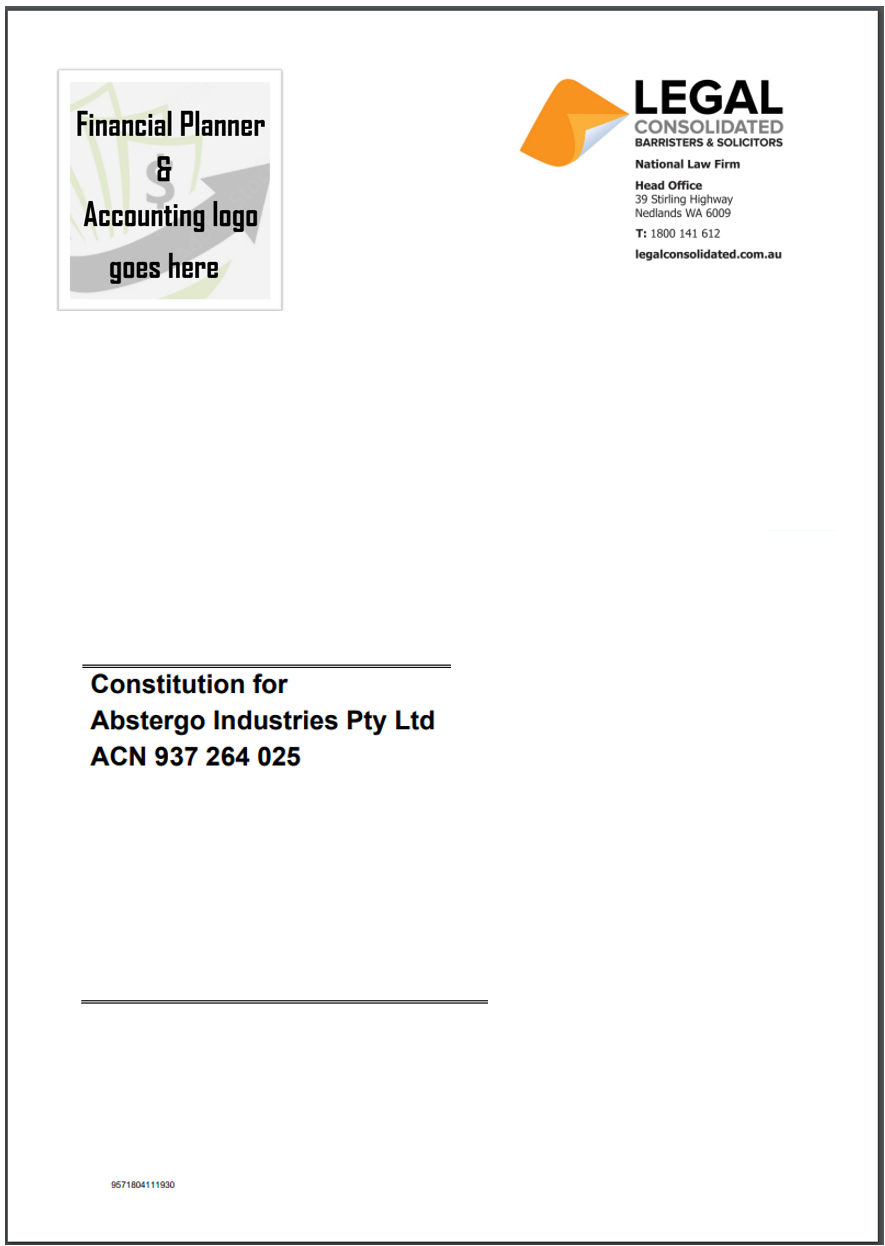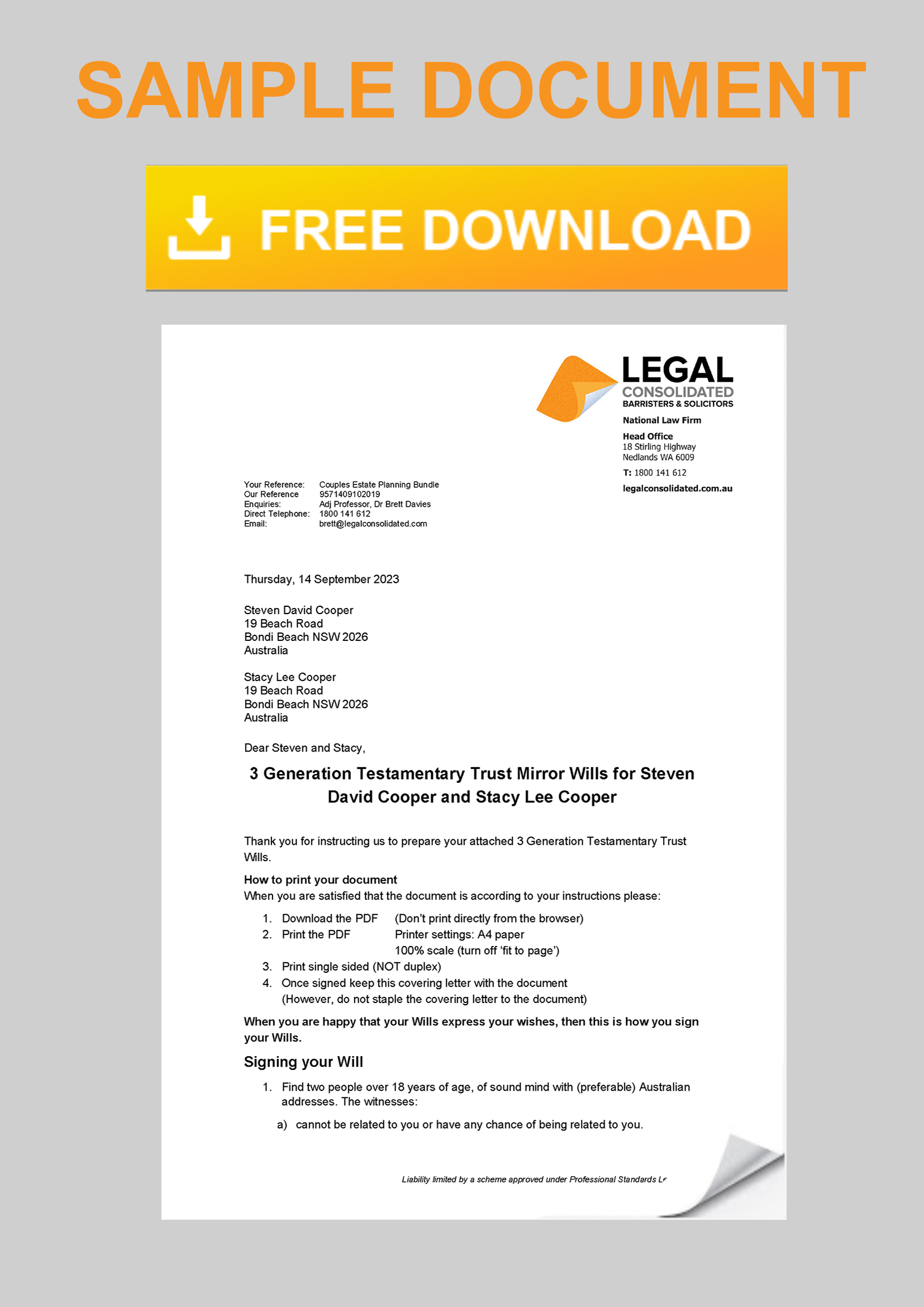
Company Constitution Replacement
$447 includes GST
-
Replace your old Memo & Articles of Association with a Constitution
Memorandum & Articles of Association in Australia – all of them are out of date
Australian companies created before 1 July 1998 had a ‘Memorandum & Articles of Association’ (Memos & Articles). Since then all newly incorporated companies should have a Constitution. (Some companies may have neither a Memo and Articles nor a Constitution. This is bad.) Memos & Articles and Constitutions both deal with how the company conducts itself.
What are Memorandum & Articles of Association?

Memos and Articles are dangerous. Update to a Constitution.
Once upon a time, Australian companies operated under a patchwork of different state and territory laws. Each state had its own rules, creating a fragmented system that made managing companies consistently across Australia challenging. Before the Corporations Act 2001 (Cth), companies were governed by two documents: the Memorandum of Association and the Articles of Association. These documents were the company’s rules.
However, the problem with this old system was that it was unnecessarily complicated and could easily cause confusion, especially for businesses operating in multiple states. The split between the two documents—the Memorandum and the Articles—meant that a company’s internal management rules were spread across different pieces of paper, which lead to ambiguity and contradictions.
What is the difference between a Memorandum of Association and Articles of Association?
The Memorandum of Association and the Articles of Association serve different roles in the structure of a company. Each document covers different aspects of company governance and operations.
1. Memorandum of Association
The Memorandum of Association sets out the company’s fundamental conditions upon which its operations are based. Historically, it listed the company’s objectives, and any action taken outside these objectives was considered ‘ultra vires’ (beyond the powers of the company), rendering such actions void, even if they were legal.
2. Articles of Association
Conversely, the Articles of Association focus on the management and administrative aspects of the company. They set out the rules for the internal governance and the operational framework of the company. This document sets out the powers, rights, and responsibilities of the company’s members and its senior officeholders, providing detailed guidelines on:
-
- The appointment and powers of directors.
- The appointment and responsibilities of the company secretary.
- The conduct of board and general meetings.
- The procedures surrounding the issuance, rights, and transfer of shares.
In essence, while the Memorandum of Association establishes the foundational legal identity and capabilities of the company, the Articles of Association detail how the company is to be run and how its internal processes are managed, acting as a user manual for the company’s governance.
Six Common Faults in Memorandum & Articles of Association
Your old Memorandum & Articles of Association may still operate. But not well. Faults with the old Memo & Articles: 
1. Memos & Articles require an AGM each year
Requiring an Annual General Meeting (AGM). However, the law no longer requires an AGM for Pty Ltd companies. No one has AGMs anymore. But if you don’t then your company is non-compliant. This is for both taxation and insolvency laws. Your new Constitution ensures that you do not have to have AGMs anymore.
2. Memos & Articles require a ‘purpose’
The Memo & Articles contain a ‘list of objects’. This is the purpose of the company. E.g. ‘sell fishing tackle and retail’.
What if your company now does something else, such as acting as a trustee of a doctor’s surgery? Then you break the law. Your company is acting ‘ultra vires’. It is acting outside its powers. Again, your company is non-compliant. Legal Consolidated’s Constitution allows you to do anything a human can do – and more
Your company is no longer restricted in what it can and can not do.
3. Memos & Articles require two directors. Two directors go bankrupt, instead of one
Memos & Articles require two directors. As stated above, the laws changed. You now only need one director. It is safer to only have one director in case the company goes insolvent
Good asset protection requires one director – not two.
4. Old Memo & Articles require you to perform out-of-date and illegal actions
Old Memo & Articles require strange and sometimes illegal behaviour. Instead, update the company constitution to allow these correct powers:
- exercise corporate powers
- issue and allot shares
- not avoid liability (a strange requirement)
- transfer shares
- vote and proxies
- appoint directors and company secretary
- conduct general and director meetings
- sign bank documents, loans and mortgages (however, this may be useful because banks often cannot enforce a loan made by a company that is still working under old Memorandum & Articles of Association)
Be safe. Update to a Legal Consolidated Barristers & Solicitors’ Constitution
5. Memos & Articles lead to you acting outside the rules – ‘ultra vires’
The Memorandum of Association forces specific and limited objectives for a company, setting a rigid framework for its operations. Any action taken outside these predefined objectives is termed ‘ultra vires’—beyond the powers of the company. Such actions are void and unenforceable, regardless of their legality.
This restrictive approach hampers the company’s ability to adapt and expand into new areas, stifling innovation and operational agility. Furthermore, when a company becomes insolvent, liquidators often scrutinise these ultra vires activities, attempting to demonstrate that directors should be held accountable along with the sinking ship, particularly if shareholders allowed the company to engage in activities that were not authorised.
To address this, adopting a modernised Constitution removes these limitations, granting broader powers. This enables the company to engage in a wider array of activities without the risk of ultra vires challenges, thus significantly enhancing its legal and operational flexibility and protecting directors and shareholders in cases of insolvency.
6. Memos & Articles are highly restrictive
In addition to defining a company’s purpose, the Memorandum of Association reduced the company to several key elements:
- The company’s name
- Its share capital structure
- Its registered physical office
- The relationship between the company and its shareholders, including shareholder liability
These parameters are rigid and have the drawback of relying solely on the Memorandum of Association. Activities deemed ‘ultra vires’ expose the company to significant legal and operational risks, highlighting the limitations and inherent dangers in such an inflexible framework. They were often used by liquidators to trip up the directors.
Build the Legal Consolidated Constitution to remove all of these restrictions.
Replace Memos & Articles of Association on our law firm’s website
You are about to replace your old Memo & Articles with a Company Constitution on our law firm’s website. You are building everything you need including:
- Law firm covering letter
- Member Minutes
- New Constitution
See a full sample of the cover letter, minutes and new Constitution above.

You are welcome to add your logo to our law firm’s documents for free.
ASIC requires nothing when you get rid of your old Memorandum & Articles of Association.
Do not send a copy of the new Constitution to ASIC. There are also no ASIC fees. This is when you replace your old Memorandum and Articles with a Legal Consolidated Constitution.
Every Member signs the Member Minutes
As we have drafted the update, each shareholder signs to give their consent. If you can’t get every shareholder to sign please telephone us. If the shareholder is dead their executor signs the Minutes, instead.
What is a Company Constitution?
The Constitution is a contract between the company, directors and shareholders (members). It is not mandatory to create a Constitution. Your internal procedures are, instead, governed by government Replaceable Rules. However, no accountants, lawyers or financial advisers would advise your company to rely on these Replaceable Rules. This is because Replaceable Rules are not tailored to your specific needs. Relying on Replaceable Rules is dangerous.
Constitution vs Replaceable Rules
Your company must have a set of rules. The rules are either:
- A Constitution – which you are about to build; or failing that
- Replacement Rules – set out in the Corporations Act
We often review a company incorporated on a non-law firm’s website. To ‘save time’ the non-law firm website adopts Replacement Rules for:
- a sole director, sole member company; or
- a Self-Managed Super Fund corporate trustee (special purpose company)
However, both of these companies must have a Constitution. Further, the Replaceable Rules are the bare minimum. There are additional powers that a company should have – our Constitution contains these additional powers and benefits. Also, the Replaceable Rules change at the whim of the current government. While the changes may benefit ‘society’ they may not be in the best interests of the shareholders. In contrast, constitutions can be amended at any time by the Members, just as you are about to do.
The 8 improvements to your old Memorandum and Articles of Association
The Constitution you are building updates your company’s internal rules and procedures. Your old Memorandum and Articles of Association set out the internal rules. Now your new Constitution does that job. Your new Constitution fully complies with changes to the Corporations Act. The 8 improvements are:
1. No Technology in old Memo & Articles
Technology has changed how a board can communicate with itself, employees and shareholders. When you replace a Company Constitution it is updated to reflect how changes in technology affect your business operations. Traditionally board decisions are mailed out in physical form to shareholders. However, email is a faster form of communication that is used by many businesses to correspond with shareholders. Your updated constitution takes into consideration how instantaneous communication affects your shareholders. Further, your constitution outlines how technology can be used in meetings.
2. Dividends and old company constitution
In 2010, the Australian government amended section 254 of the Corporations Act. This section governs how dividends are paid.
Before 2010 the Corporations Act stated that dividends could only be paid from company profits. However, after 2010 a company is not allowed to declare a dividend unless:
- the company’s assets exceed its liabilities; and
- the payment is fair and reasonable; and
- the payment does not materially prejudice the company’s ability to pay its creditors.
Under an old constitution, you may not have been able to pay dividends legally. Insolvency specialists pursue this argument. They challenge all dividends that you have paid since 2010.
3. Email voting in Memo & Articles
Shareholders can cast a vote regarding a meeting. Do it either online or through personalised voting forms. Members do not need to attend the meeting and can appoint a proxy. Your new Constitution improves meeting efficiency.
4. Share buybacks not allowed in old Constitutions
Share buybacks allow companies to buy back their shares from the shareholders. In Australia, there are 5 types of share buybacks. They are equal access, on-market, employee share scheme, selective buy-back and minimum holding. Replace a Company Constitution and ensure the legality of the share buyback.
5. Preference shares in an updated Constitution
A company has the power to issue preference shares under Australian law. Your new Constitution ensures that the preference shares are clear.
6. Single Directors are not allowed 
The Law Simplification Act 1995 (Cth) reduced the number of directors necessary for a company from two to one. Before then, you needed a minimum of two directors. This would often be a wife and a husband. The change was to allow women to start their businesses.
You now get away with just one director for your company. Most companies only have a single director.
Having two directors was a disaster for asset protection. Instead of one, both directors go bankrupt along with the insolvent company. Owe money to the ATO for PAYG or superannuation? Then all the directors are liable automatically for such unpaid debts. With a single director, only one person goes down if the company is insolvent.
Asset protection is having no assets in a risky person’s name. Instead, assets are in the safe person’s name. This is called the ‘man of straw and the woman of substance’.
The new Constitution you are building allows you to have a single director.
7. Director’s resignations do not work if the company requires 2 directors
Companies can have two types of written rules. The rules are set out either in the Articles of Association or the Constitution.
Since 1995 you can have single-director companies. Yet, there are:
- over 27,000 Memorandum & Articles of Association;
- there are 59,000 Constitutions in Australia
that still requires that the company have two directors.
We review brand-new company Constitutions incorporated on a non-law firm website. Many still require the company to have two directors!
What if your rules say two directors – but one of you wants to resign?
You may try and resign as a director. You may lodge the correct form with ASIC to resign as a director. ASIC may accept the form. But the resignation is void as against a company liquidator and a trustee in bankruptcy.
This can be rectified by updating your company rules.
Also, if a company does not have enough officers, it breaches the Corporations Act 2001. This company pays penalties and is prosecuted for not meeting its obligations:
8. Inbuilt into the Company Constitution is a Division 7A Loan Agreement
Legal Consolidated’s replacement Constitution includes a Division 7A Loan Agreement. This is part of the Constitution. It is built into the Constitution. It works for each Member and any new Member. (The expression ‘member’ and ‘shareholder’ are the same.)
Why should your new Constitution contain a Div7A agreement for the shareholders?
Division 7A of the Income Tax Assessment Act 1936, penalises loans, payments, and debts deemed to be ‘forgiven’ by the Pty Ltd company to its shareholder or their ‘associates’. (If Dad is the shareholder then his wife and children are examples of ‘associates’.) Companies pay tax at a constant tax rate. This may be a much lower tax rate than the shareholder or their associate. Div 7A stops this arbitrate advantage.
Div7A prevents the private company profits and assets from being distributed to the shareholder without the shareholder being required to pay the ‘top-up tax’. But you need a complying Division 7A agreement to stop the draconian effect of Div7A. Without a complying Div7A Loan Agreement, the penalty tax rate is almost 100% of the money that the company is deemed to have loaned or forgiven.
Does the inbuilt Div7A Agreement work for people who are not shareholders?
No, it does not. This is because the Constitution is a contract between the company and its shareholders (from time to time). The shareholder’s spouse and children are not themselves shareholders. They are ‘associates’ under the Div7A rules. Therefore, the Company Constitution does not bind or concern them. Non-shareholders of the Pty Ltd company still need to build their own Division 7A Loan Agreement.
Business Structures when using a company
Family trust v a company
- Family Trust Deed – watch the free training course
- Family Trust Updates:
- Everything – Appointor, Trustee & Deed Update
- Deed ONLY – only update the Deed for tax
- Guardian and Appointor – only update the Guardian & Appointor
- Change the Trustee – change human Trustees and Company Trustees
- The company as Trustee of Family Trust – only for assets protection?
- Bucket Company for Family Trust – tax advantages of a corporate beneficiary
Unit trust vs Company
- Unit Trust
- Unit Trust Vesting Deed – wind up your Unit Trust
- Change Unit Trust Trustee – replace the trustee of your Unit Trust
- Company as Trustee of Unit Trust – how to build a company designed to be a trustee of a Unit Trust
Corporate structures to be used with a company
- Partnership Agreement – but what about joint liability?
- Incorporate an Australian Company – best practice with the Constitution
- Upgrade the old Company Constitution – this is why
- Replace lost Company Constitution – about to get an ATO Audit?
How do Service Trusts work with a company
- Independent Contractor Agreement – make sure the person is NOT an employee
- Service Trust Agreement – operate a second business to move income and wealth
- Law firm Service Trust Agreement – how a law firm runs the backend of its practice
- Medical Doctor Service Trust Agreement – complies with all State rules, including New South Wales
- Dentist Service Trust Agreement – how dentists move income to their family
- Engineering Service Trust Agreement – commonly engineers set up the wrong structure
- Accountants Service Trust Agreement – complies with ATO’s new view on the Phillips case
| Upgrade Company Constitution – also allows for single director company | $447 |
| Replace Old Memo and Articles of Association – upgrade from Replaceable Rules | $447 |
| Replace Lost Company Constitution | $447 |
| Convert Old Company Into a Special Purpose Company – to be trustee of SMSF | $447 |
| Replace Replaceable Rules | $447 |
